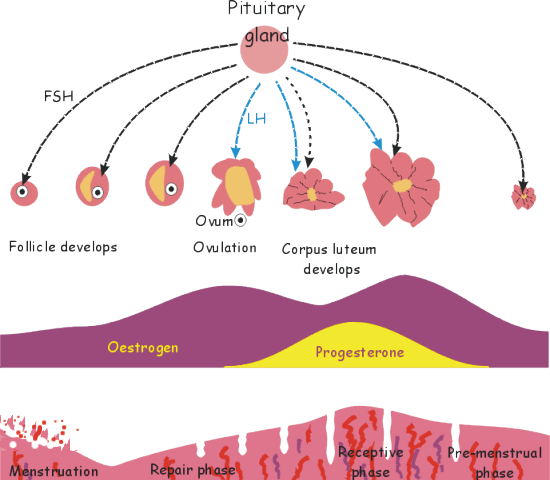Sex Hormones
Control of the Menstrual Cycle
The menstrual cycle is a regular series of changes which prepare the female reproductive for the fertilization of the ovum and the resulting pregnancy. It is under the control of a number of hormones.
| Hormone | Produced By |
|---|---|
| Follicle Stimulating Hormone (FSH) Luteinising Hormone (LH) |
Pituitary Gland |
| Progesterone Oestrogen |
Ovary |

The cycle is controlled by the hypothalamus of the brain. This acts a biological clock to regulate the cycle. It stimulates at different times the release of FSH and LH from the pituitary gland. The cycle begins with menstruation, the breakdown of the uterine wall. The pituitary gland releases FSH which effects one of the immature ova in one ovary. The immature ova develops into a follicle which feeds and prepares the ova in readiness for ovulation. The developing follicle releases oestrogen which affects the uterus wall and stimulates it to grow and thicken. When the follicle is mature the pituitary gland releases LH which causes the follicle to give up its ovum in ovulation.
Further release of LH causes the follicle to develop into a body known as a Corpus Luteum. The corpus luteum produces another hormone, progesterone. This hormone stimulates the uterus lining and prepares it for pregnancy. If the ovum is not fertilized the corpus luteum degenerates and stops producing progesterone. It is the fall in the levels of this hormone which brings about menstruation.
Birth Control Pill
The hormones oestrogen and progesterone are used to in birth control. High levels of these two hormones in the blood can be found during pregnancy. If a woman is pregnant there is no need to ovulate during this time. By artificially introducing these hormones, the high levels found during pregnancy can be mimicked and the body does not release an egg as a result. There is a progesterone only pill (often called the mini-pill) which works by making the uterus harder for the sperm to swim through due to sticky fluid being produced.
